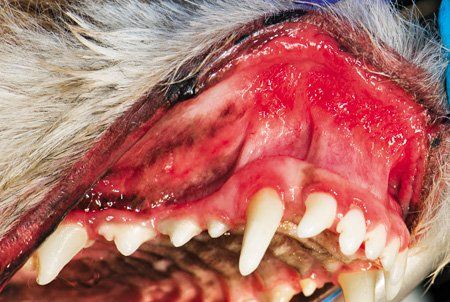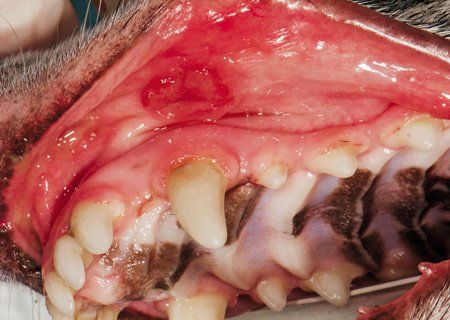Image Quiz: Whats wrong with this Malteses mouth?
Thick, ropey saliva and a painful patient: Whats the deal?
This 14-year-old Maltese cross was brought into the clinic because it had stopped eating. Putrid saliva and severe halitosis are evident. The dog's history consists of multiple professional teeth cleanings, a few tooth extractions, and antibiotic, corticosteroid and immune modulator administration. Upon examining the dog's mouth, you see the following:

See signs on alveolar mucosa apical to the adjacent teeth.

See signs adjacent to the right and left maxillary canines and incisors with minimal periodontal inflammation, plaque or tartar.Which is the most likely diagnosis?
a) Contact mucositis with ulceration
b) Pemphigus vulgaris
c) Epidermolysis bullosa
d) Squamous cell carcinoma
e) Early effects of toxic epidermal necrolysis
Answer
a) That's right-ulcers.
Chronic ulcerative paradental stomatitis (CUPS)-also called contact mucositis, contact mucositis with ulceration and kissing lesions-affects the paradental mucosal tissues that lie next to the teeth. The oral mucosa, palatal mucosa, lining of the buccal pouch and epithelial lining of the tongue are most commonly affected.
The specific etiology is unknown. Maltese, Cavalier King Charles spaniels, Labrador retrievers and greyhounds are overrepresented. Affected animals may have a hyperimmune response to the bacteria and proteins in plaque. Other syndromes that may mimic contact ulcerative mucositis include autoimmune diseases such as mucous membrane pemphigoid, bullous pemphigoid, pemphigus vulgaris, epidermolysis bullosa and epitheliotropic T-cell lymphoma. Additionally drug reactions (early toxic epidermal necrolysis) and foreign bodies appear similar. Keep in mind that in cases of pemphigus, other mucous membranes including the inner surfaces of the eyelids and the rectum can also be affected.
Unfortunately most affected patients are in so much pain they will not allow an oral examination. As part of patient assessment, perform a complete blood count, a serum chemistry profile, a complete urinalysis and thyroid screening. In patients in which elevated alkaline phosphatase activities are reported, also perform tests to rule out Cushing's disease.
The treatment of patients with CUPS lesions involves medical intervention, surgical intervention or a combination of the two. Initial care involves dental scaling and antibiotics to help treat severe presentations. Pain relief medication is also indicated. The use of corticosteroids to control CUPS is controversial. Home care, including brushing the pet's teeth twice daily, applying a gel or an oral rinse containing zinc and applying plaque prevention gel (OraVet Plaque Prevention Gel-Merial), helps with plaque control and ulcer treatment.
The surgical intervention of choice is photovaporization with a carbon dioxide laser.
In advanced cases in which the owner cannot provide twice-daily plaque control or if such care does not meet with clinical success, removal of the teeth adjacent to the ulcerated areas-and in some cases all the teeth, as in the case of this dog results in rapid elimination of all infection and pain.
Want even more details on CUPS? Click here.
Dr. Jan Bellows owns All Pets Dental in Weston, Florida. He is a diplomate of the American Veterinary Dental College and the American Board of Veterinary Practitioners. He can be reached at (954) 349-5800 and dentalvet@aol.com.